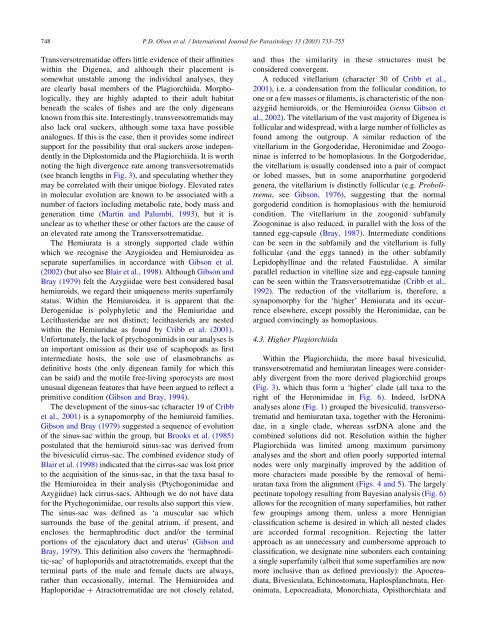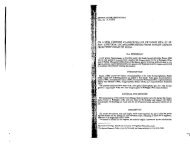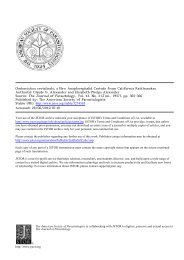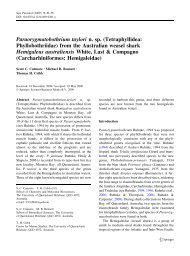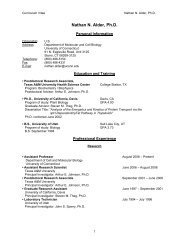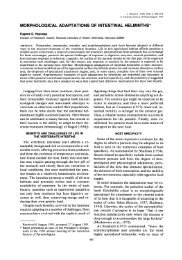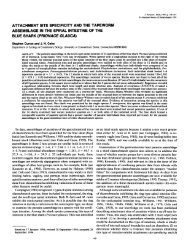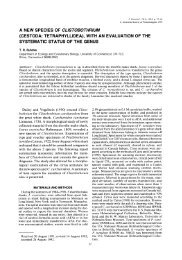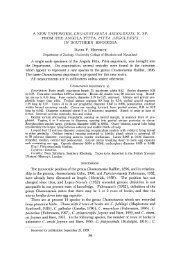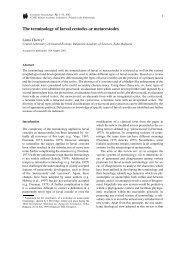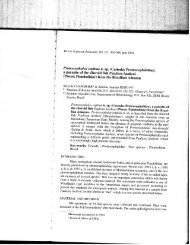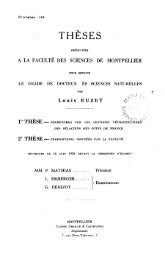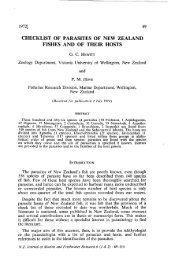Phylogeny and classification of the Digenea (Platyhelminthes ...
Phylogeny and classification of the Digenea (Platyhelminthes ...
Phylogeny and classification of the Digenea (Platyhelminthes ...
You also want an ePaper? Increase the reach of your titles
YUMPU automatically turns print PDFs into web optimized ePapers that Google loves.
748P.D. Olson et al. / International Journal for Parasitology 33 (2003) 733–755Transversotrematidae <strong>of</strong>fers little evidence <strong>of</strong> <strong>the</strong>ir affinitieswithin <strong>the</strong> <strong>Digenea</strong>, <strong>and</strong> although <strong>the</strong>ir placement issomewhat unstable among <strong>the</strong> individual analyses, <strong>the</strong>yare clearly basal members <strong>of</strong> <strong>the</strong> Plagiorchiida. Morphologically,<strong>the</strong>y are highly adapted to <strong>the</strong>ir adult habitatbeneath <strong>the</strong> scales <strong>of</strong> fishes <strong>and</strong> are <strong>the</strong> only digeneansknown from this site. Interestingly, transversotrematids mayalso lack oral suckers, although some taxa have possibleanalogues. If this is <strong>the</strong> case, <strong>the</strong>n it provides some indirectsupport for <strong>the</strong> possibility that oral suckers arose independentlyin <strong>the</strong> Diplostomida <strong>and</strong> <strong>the</strong> Plagiorchiida. It is worthnoting <strong>the</strong> high divergence rate among transversotrematids(see branch lengths in Fig. 3), <strong>and</strong> speculating whe<strong>the</strong>r <strong>the</strong>ymay be correlated with <strong>the</strong>ir unique biology. Elevated ratesin molecular evolution are known to be associated with anumber <strong>of</strong> factors including metabolic rate, body mass <strong>and</strong>generation time (Martin <strong>and</strong> Palumbi, 1993), but it isunclear as to whe<strong>the</strong>r <strong>the</strong>se or o<strong>the</strong>r factors are <strong>the</strong> cause <strong>of</strong>an elevated rate among <strong>the</strong> Transversotrematidae.The Hemiurata is a strongly supported clade withinwhich we recognise <strong>the</strong> Azygioidea <strong>and</strong> Hemiuroidea asseparate superfamilies in accordance with Gibson et al.(2002) (but also see Blair et al., 1998). Although Gibson <strong>and</strong>Bray (1979) felt <strong>the</strong> Azygiidae were best considered basalhemiuroids, we regard <strong>the</strong>ir uniqueness merits superfamilystatus. Within <strong>the</strong> Hemiuroidea, it is apparent that <strong>the</strong>Derogenidae is polyphyletic <strong>and</strong> <strong>the</strong> Hemiuridae <strong>and</strong>Lecithasteridae are not distinct; lecithasterids are nestedwithin <strong>the</strong> Hemiuridae as found by Cribb et al. (2001).Unfortunately, <strong>the</strong> lack <strong>of</strong> ptychogonimids in our analyses isan important omission as <strong>the</strong>ir use <strong>of</strong> scaphopods as firstintermediate hosts, <strong>the</strong> sole use <strong>of</strong> elasmobranchs asdefinitive hosts (<strong>the</strong> only digenean family for which thiscan be said) <strong>and</strong> <strong>the</strong> motile free-living sporocysts are mostunusual digenean features that have been argued to reflect aprimitive condition (Gibson <strong>and</strong> Bray, 1994).The development <strong>of</strong> <strong>the</strong> sinus-sac (character 19 <strong>of</strong> Cribbet al., 2001) is a synapomorphy <strong>of</strong> <strong>the</strong> hemiuroid families.Gibson <strong>and</strong> Bray (1979) suggested a sequence <strong>of</strong> evolution<strong>of</strong> <strong>the</strong> sinus-sac within <strong>the</strong> group, but Brooks et al. (1985)postulated that <strong>the</strong> hemiuroid sinus-sac was derived from<strong>the</strong> bivesiculid cirrus-sac. The combined evidence study <strong>of</strong>Blair et al. (1998) indicated that <strong>the</strong> cirrus-sac was lost priorto <strong>the</strong> acquisition <strong>of</strong> <strong>the</strong> sinus-sac, in that <strong>the</strong> taxa basal to<strong>the</strong> Hemiuroidea in <strong>the</strong>ir analysis (Ptychogonimidae <strong>and</strong>Azygiidae) lack cirrus-sacs. Although we do not have datafor <strong>the</strong> Ptychogonimidae, our results also support this view.The sinus-sac was defined as ‘a muscular sac whichsurrounds <strong>the</strong> base <strong>of</strong> <strong>the</strong> genital atrium, if present, <strong>and</strong>encloses <strong>the</strong> hermaphroditic duct <strong>and</strong>/or <strong>the</strong> terminalportions <strong>of</strong> <strong>the</strong> ejaculatory duct <strong>and</strong> uterus’ (Gibson <strong>and</strong>Bray, 1979). This definition also covers <strong>the</strong> ‘hermaphroditic-sac’<strong>of</strong> haploporids <strong>and</strong> atractotrematids, except that <strong>the</strong>terminal parts <strong>of</strong> <strong>the</strong> male <strong>and</strong> female ducts are always,ra<strong>the</strong>r than occasionally, internal. The Hemiuroidea <strong>and</strong>Haploporidae þ Atractotrematidae are not closely related,<strong>and</strong> thus <strong>the</strong> similarity in <strong>the</strong>se structures must beconsidered convergent.A reduced vitellarium (character 30 <strong>of</strong> Cribb et al.,2001), i.e. a condensation from <strong>the</strong> follicular condition, toone or a few masses or filaments, is characteristic <strong>of</strong> <strong>the</strong> nonazygiidhemiuroids, or <strong>the</strong> Hemiuroidea (sensu Gibson etal., 2002). The vitellarium <strong>of</strong> <strong>the</strong> vast majority <strong>of</strong> <strong>Digenea</strong> isfollicular <strong>and</strong> widespread, with a large number <strong>of</strong> follicles asfound among <strong>the</strong> outgroup. A similar reduction <strong>of</strong> <strong>the</strong>vitellarium in <strong>the</strong> Gorgoderidae, Heronimidae <strong>and</strong> Zoogoninaeis inferred to be homoplasious. In <strong>the</strong> Gorgoderidae,<strong>the</strong> vitellarium is usually condensed into a pair <strong>of</strong> compactor lobed masses, but in some anaporrhutine gorgoderidgenera, <strong>the</strong> vitellarium is distinctly follicular (e.g. Probolitrema,see Gibson, 1976), suggesting that <strong>the</strong> normalgorgoderid condition is homoplasious with <strong>the</strong> hemiuroidcondition. The vitellarium in <strong>the</strong> zoogonid subfamilyZoogoninae is also reduced, in parallel with <strong>the</strong> loss <strong>of</strong> <strong>the</strong>tanned egg-capsule (Bray, 1987). Intermediate conditionscan be seen in <strong>the</strong> subfamily <strong>and</strong> <strong>the</strong> vitellarium is fullyfollicular (<strong>and</strong> <strong>the</strong> eggs tanned) in <strong>the</strong> o<strong>the</strong>r subfamilyLepidophyllinae <strong>and</strong> <strong>the</strong> related Faustulidae. A similarparallel reduction in vitelline size <strong>and</strong> egg-capsule tanningcan be seen within <strong>the</strong> Transversotrematidae (Cribb et al.,1992). The reduction <strong>of</strong> <strong>the</strong> vitellarium is, <strong>the</strong>refore, asynapomorphy for <strong>the</strong> ‘higher’ Hemiurata <strong>and</strong> its occurrenceelsewhere, except possibly <strong>the</strong> Heronimidae, can beargued convincingly as homoplasious.4.3. Higher PlagiorchiidaWithin <strong>the</strong> Plagiorchiida, <strong>the</strong> more basal bivesiculid,transversotrematid <strong>and</strong> hemiuratan lineages were considerablydivergent from <strong>the</strong> more derived plagiorchiid groups(Fig. 3), which thus form a ‘higher’ clade (all taxa to <strong>the</strong>right <strong>of</strong> <strong>the</strong> Heronimidae in Fig. 6). Indeed, lsrDNAanalyses alone (Fig. 1) grouped <strong>the</strong> bivesiculid, transversotrematid<strong>and</strong> hemiuratan taxa, toge<strong>the</strong>r with <strong>the</strong> Heronimidae,in a single clade, whereas ssrDNA alone <strong>and</strong> <strong>the</strong>combined solutions did not. Resolution within <strong>the</strong> higherPlagiorchiida was limited among maximum parsimonyanalyses <strong>and</strong> <strong>the</strong> short <strong>and</strong> <strong>of</strong>ten poorly supported internalnodes were only marginally improved by <strong>the</strong> addition <strong>of</strong>more characters made possible by <strong>the</strong> removal <strong>of</strong> hemiuratantaxa from <strong>the</strong> alignment (Figs. 4 <strong>and</strong> 5). The largelypectinate topology resulting from Bayesian analysis (Fig. 6)allows for <strong>the</strong> recognition <strong>of</strong> many superfamilies, but ra<strong>the</strong>rfew groupings among <strong>the</strong>m, unless a more Hennigian<strong>classification</strong> scheme is desired in which all nested cladesare accorded formal recognition. Rejecting <strong>the</strong> latterapproach as an unnecessary <strong>and</strong> cumbersome approach to<strong>classification</strong>, we designate nine suborders each containinga single superfamily (albeit that some superfamilies are nowmore inclusive than as defined previously): <strong>the</strong> Apocreadiata,Bivesiculata, Echinostomata, Haplosplanchnata, Heronimata,Lepocreadiata, Monorchiata, Opisthorchiata <strong>and</strong>


